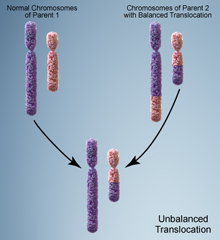
A team of researchers has discovered a genetic syndrome that causes childhood obesity, intellectual disability and seizures. The syndrome comes from an "unbalanced" chromosomal translocation: affected individuals have additional copies of genes from one chromosome and fewer copies of genes from another.
The results were published this week in Proceedings of the National Academy of Sciences, Early Edition.
Katie Rudd, PhD, assistant professor of human genetics at Emory University School of Medicine, is senior author of the paper. Research specialist Ian Goldlust, now a graduate student in the NIH-Oxford-Cambridge Scholars Program, is the first author. Co-authors include investigators from around the USA and Australia.
Rudd's team was able to connect the contribution of one gene, GNB3, among many involved in the translocation, to the obesity aspect of the syndrome. Her lab created a mouse model with an extra copy of the GNB3 gene and found that the mice are obese. The mice are on average 6 percent (males) or 10 percent (females) heavier.
Rudd says her work was greatly assisted by collaboration with the Unique Rare Chromosome Disorder Support Group, a UK-based charity. Within Unique, a few parents had together found that their children had translocations involving the same chromosomes and similar symptoms. They contacted Rudd and helped her find additional affected families. Her study includes seven unrelated patients.
"It really was a group effort, and Unique was the linchpin," she says. "Managing to find seven families with exactly the same rare translocation would have been extremely difficult otherwise."
After seeing that the GNB3 gene was part of the translocation, Rudd says her lab decided to focus on it more closely. The GNB3 gene has been extensively studied since the 1990s, when one form of the gene was found to be present more often in people with hypertension.
A one letter alternative spelling (geneticists know these as single nucleotide polymorphisms or SNPs) of GNB3 has been linked to obesity*, diabetes, and responses to antidepressants and other types of drugs. It has also been found to be more common in elite endurance athletes, and the SNP's discoverer describes it as representing a "thrifty genotype."
It is important to note that the SNP changes only one letter of the gene, modifying how the gene's RNA is spliced, and appears to result in increased activity. In contrast, individuals affected by the translocation have an entire extra copy. The mouse model has an extra copy of the human "risk allele" version of the GNB3 gene.
Rudd says her lab is now investigating whether the risk allele is required for the obesity effect in mice, and looking at alterations of metabolism and hormones in the mice. She also plans to examine whether an extra copy of GNB3 also leads to other aspects of the human syndrome such as seizures or altered brain development, although she says it's likely that other genes in the translocation contribute to the intellectual disability aspect.
GNB3 is one of several genes encoding "G proteins," parts of the cellular machinery involved in responses to odors, hormones and neurotransmitters. G-protein coupled receptors are the targets of many drugs, ranging from antipsychotics to antihistamines and anti-reflux proton pump blockers.
*Geneticists have estimated the heritability of obesity to be around 70 percent. That's not as high as eye color or having curly hair, but it's still higher than many other conditions that are partially heritable.
The research was supported by the National Institutes of Mental Health (5R01MH92902) and the Emory Discovery Fund.
Reference: I.S. Goldlust et al. Mouse model implicates GNB3 duplication in a childhood obesity syndrome. PNAS Early Edition (2013).
